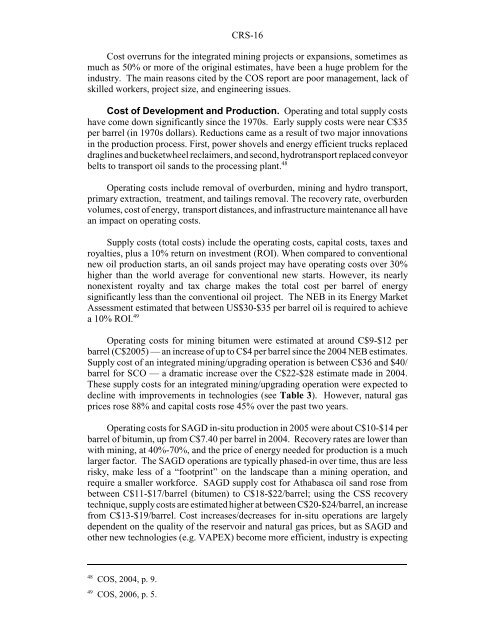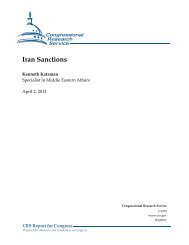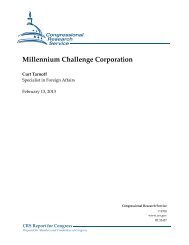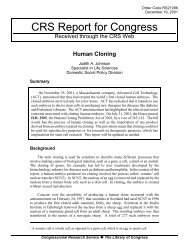North American Oil Sands: History of ... - The Air University
North American Oil Sands: History of ... - The Air University
North American Oil Sands: History of ... - The Air University
Create successful ePaper yourself
Turn your PDF publications into a flip-book with our unique Google optimized e-Paper software.
48 COS, 2004, p. 9.<br />
49 COS, 2006, p. 5.<br />
CRS-16<br />
Cost overruns for the integrated mining projects or expansions, sometimes as<br />
much as 50% or more <strong>of</strong> the original estimates, have been a huge problem for the<br />
industry. <strong>The</strong> main reasons cited by the COS report are poor management, lack <strong>of</strong><br />
skilled workers, project size, and engineering issues.<br />
Cost <strong>of</strong> Development and Production. Operating and total supply costs<br />
have come down significantly since the 1970s. Early supply costs were near C$35<br />
per barrel (in 1970s dollars). Reductions came as a result <strong>of</strong> two major innovations<br />
in the production process. First, power shovels and energy efficient trucks replaced<br />
draglines and bucketwheel reclaimers, and second, hydrotransport replaced conveyor<br />
belts to transport oil sands to the processing plant. 48<br />
Operating costs include removal <strong>of</strong> overburden, mining and hydro transport,<br />
primary extraction, treatment, and tailings removal. <strong>The</strong> recovery rate, overburden<br />
volumes, cost <strong>of</strong> energy, transport distances, and infrastructure maintenance all have<br />
an impact on operating costs.<br />
Supply costs (total costs) include the operating costs, capital costs, taxes and<br />
royalties, plus a 10% return on investment (ROI). When compared to conventional<br />
new oil production starts, an oil sands project may have operating costs over 30%<br />
higher than the world average for conventional new starts. However, its nearly<br />
nonexistent royalty and tax charge makes the total cost per barrel <strong>of</strong> energy<br />
significantly less than the conventional oil project. <strong>The</strong> NEB in its Energy Market<br />
Assessment estimated that between US$30-$35 per barrel oil is required to achieve<br />
a 10% ROI. 49<br />
Operating costs for mining bitumen were estimated at around C$9-$12 per<br />
barrel (C$2005) — an increase <strong>of</strong> up to C$4 per barrel since the 2004 NEB estimates.<br />
Supply cost <strong>of</strong> an integrated mining/upgrading operation is between C$36 and $40/<br />
barrel for SCO — a dramatic increase over the C$22-$28 estimate made in 2004.<br />
<strong>The</strong>se supply costs for an integrated mining/upgrading operation were expected to<br />
decline with improvements in technologies (see Table 3). However, natural gas<br />
prices rose 88% and capital costs rose 45% over the past two years.<br />
Operating costs for SAGD in-situ production in 2005 were about C$10-$14 per<br />
barrel <strong>of</strong> bitumin, up from C$7.40 per barrel in 2004. Recovery rates are lower than<br />
with mining, at 40%-70%, and the price <strong>of</strong> energy needed for production is a much<br />
larger factor. <strong>The</strong> SAGD operations are typically phased-in over time, thus are less<br />
risky, make less <strong>of</strong> a “footprint” on the landscape than a mining operation, and<br />
require a smaller workforce. SAGD supply cost for Athabasca oil sand rose from<br />
between C$11-$17/barrel (bitumen) to C$18-$22/barrel; using the CSS recovery<br />
technique, supply costs are estimated higher at between C$20-$24/barrel, an increase<br />
from C$13-$19/barrel. Cost increases/decreases for in-situ operations are largely<br />
dependent on the quality <strong>of</strong> the reservoir and natural gas prices, but as SAGD and<br />
other new technologies (e.g. VAPEX) become more efficient, industry is expecting











